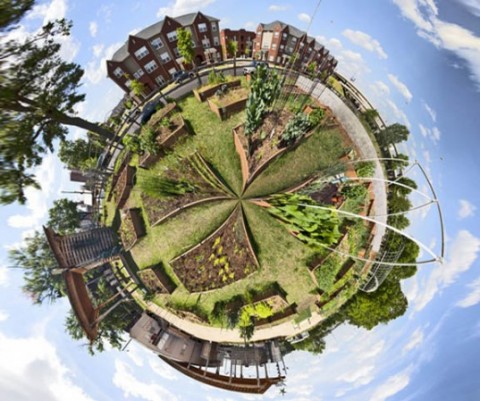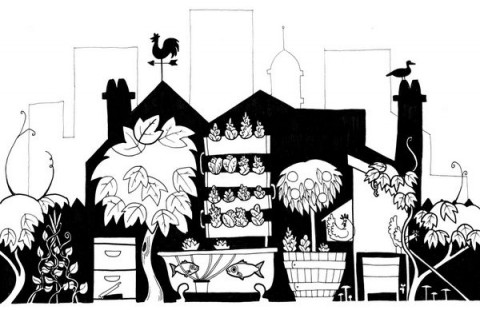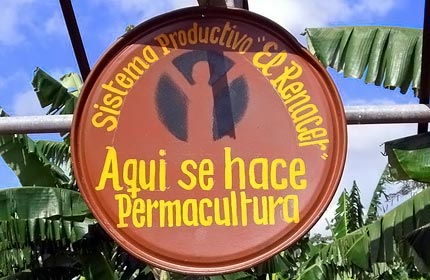Living Systems Leadership: Lessons from a Permaculture Master
July 15, 2015 Leave a commentI posted the following about five years ago on this site, and have been actively thinking about and experimenting with its core lessons ever since. I have only become more compelled by the need to bring a living systems orientation to work for social change. Curious to hear reactions and what you are already doing to apply insights from and living systems.
Part 1
Last week I was in the presence of a master. For more than 25 years, Lauren Chase-Rowell has skillfully and intuitively cultivated the land around her house in Nottingham, NH to the point that it exists in great harmony with the beautiful farm house, people and fauna occupying that space. Lauren is an ecological landscaper, organic farmer, and permaculture design teacher. Her home, Dalton’s Pasture Farm, is a vibrant classroom and testament to the possibility of practicing “earth-centered living.”
I visited Lauren at the invitation of her neighbor, Beth Tener of New Directions Collaborative, to discuss our evolving vision of creating opportunities for people to cultivate the skills and perspectives required to bring them back into right relationship with local and global ecosystems. As we discussed our beliefs about the leadership competencies for getting on track, Lauren weaved in constant metaphors from her amazing permaculture garden, which has achieved near regenerative capacity. Three that I want to share here are the concepts of biodiversity, biodynamism, and bioelasticity.
- Biodiversity – One of the keys of success to Lauren’s garden (lush despite a 4 week drought and with minimal intervention on the gardener’s part) is the inherent diversity of the system she has designed. Diversity exists with respect to the assortment of plants, trees, and shrubs in the garden as well as the life (not “pests”) intentionally attracted by these elements to help manage the system (birds, bugs, etc.). Everything serves a purpose and is honored for this, all of which serves a greater whole. The interactions between these diverse elements form a web that creates a richness and resilience beneficial to wildlife and humans alike.
- Biodynamism – Biodynamic agriculture is an approach to organic farming that has roots in the philosophy of Rudolph Steiner. Lauren seems less interested in Steiner’s specific philosophy than she is in the perspective that her garden is part of a larger systemic whole, and that its tending is aided by awareness of and action around various atmospheric and elemental cycles. In other words, she sees her garden as an open system and is aware of and works with the vital energy flows within and without.
- Bioelasticity – As described by Lauren, this concept is what drives her practice of setting aside the best specimens of each of her crop so that they go to seed and can be planted for the next season, rather than consumed. Taking a long view, she sees the plants in her garden as going through a learning curve to adjust to a particular (and changing) environment and encourages successful and ongoing adaptation by constantly reinvesting and feeding learning back into the system.
These three concepts give me a lot to consider with respect to how to practice and encourage more synergistic and regenerative leadership through paying attention to and protecting diversity, studying living systems dynamics, and supporting adaptive capacity. More insights from the master gardener tomorrow.
Part 2
Picking up from my last post, I want to share some additional insights gleaned from my tour of Lauren Chase-Rowell’s permaculture garden and land. Something else that struck me was when Lauren said that beyond her training and intuition as a master gardener, “attitude is everything.” Illustrating this statement with stories it became clear that while she is incredibly skilled in her craft, Lauren’s psychological and emotional approach take it all to another level. In essence, permaculture starts with one’s self.
Channeling Lauren, I offer these three attitudinal guidelines for your consideration and application to social change/collaborative leadership efforts, especially those geared towards leveraging the potential of living (including human) systems and collective intelligence:
- Turn problems into solutions – Lauren’s approach to problems is that they can be solutions in disguise to other problems. For example, when the local utility company cut down a number of trees on her property, a decision over which she had little influence, Lauren made lemonade by asking how she might use those downed trees, which now serve as mulch for her garden beds and shrubbery. Getting hung up on what we cannot control or hyper-focusing on isolated problems can be inefficient and unproductive. What problems are you currently facing that contain the seeds of solutions in other parts of your system?
- Lack of creativity can be the biggest limitation – The driving energy of life and systems is to create, to generate new (emergent) traits and relationships. Sometimes one of the most damaging things we can do is to stand in the way of that impulse or not join fully with that energy. When we view arrival of insects as “pestilence,” for example, and act to keep them out of a garden we may end up overlooking the valuable systemic functions of those critters and then contaminate our edens with harmful chemicals. How might you better align with the creative impulse of the system in which you are working so that it can better do what it was meant to or evolve to what it wants to be?
- Mistakes are tools for learning – Lauren is an exemplar of the mantra “improve not prove.” As an educator and consummate learner, she understands that mistakes are the crucial seeds of insight and better practice. Mistakes are not to be taken personally or as license to beat ourselves up. Rather, they are to be harvested, mulled over and fed back into the system. Were we to truly embrace the ethic of learning then we could better align with nature’s tendency to prototype, innovate, and adapt. What is your attitude towards learning and making mistakes in your leadership and change efforts? How might you better enable a culture of learning?
Happy gardening!


